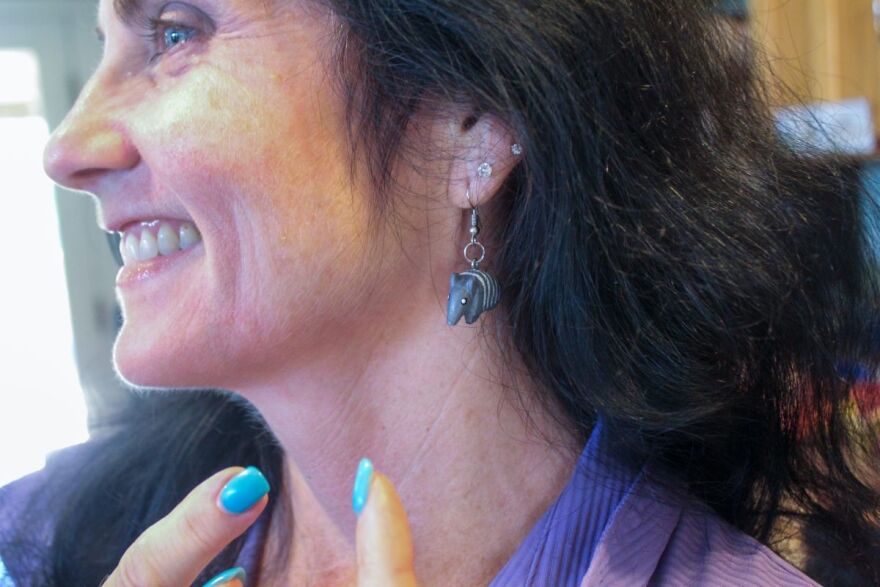Across the rolling plains of the Midwest, a new species has arrived. Sturdy, unexpected, and hailing from the Texas brush, the armadillo is here to stay.
Allen, a nine-banded armadillo, lives at Second Chances Wildlife Center in Mt. Washington, Kentucky, just outside Louisville.
After a dog attack left him covered in slashes, Allen the armadillo was rescued. Now he’s the most “high-maintenance” resident, said Brigette Brouillard, the center’s founder — “on more supplements than all the other animals combined.”
The rescue, which usually takes in everything from possums to skunks to bats, got its first armadillo six years ago — a newcomer named Arnie. Brouillard had to learn on the fly; she’d never cared for an armadillo before. Now, as armadillos push farther into the Midwest, that crash course has become a valuable skill. Other rehabbers are already calling, asking if she can take in their armadillos, too.
“I had to learn how to care for these guys,” Brouillard said.
Allen and Arnie aren’t alone. Armadillos have been steadily moving north — from Texas to Illinois — as warmer winters driven by climate change and human-shaped landscapes make survival easier. More are now calling Indiana home, one of four Midwestern states — along with Illinois, Missouri and Kentucky — where the species is considered established.
In the past two decades, more than 200 armadillos have been reported in Indiana. The U.S. Geological Survey estimates that Marion County and surrounding areas may now host breeding populations — meaning the animals are considered “established.” Indiana Department of Natural Resources mammologist Brad Westrich said that 75% of Indiana’s total armadillo reports have occurred since 2018.
Preliminary studies are still underway on how armadillos might affect the state’s ecosystems, other wildlife, and even the animals themselves. For now, they aren’t facing much resistance from the Midwest’s natural predators, like coyotes and bobcats, and could outcompete smaller species that feed on the same insects.
In the Midwest, their main competition for resources comes from moles and shrews, which also feed on insects. With few natural predators, armadillos may be able to expand their numbers quickly in their new home.
“I think we're going to see just a population that doesn't have a huge predation pressure,” Westrich said, “And they'll be able to grow and expand rapidly.”

And for armadillos like Allen with special medical needs, it can be difficult to find more specialized care in a region that is still learning about the new species itself.
“Really, it's a miracle that he is alive right now,” Brouillard said while holding Allen, who maintains a spunky spirit despite needing a blood transfusion, and continues to put on weight.

What more armadillos mean for wildlife, people and the land
Agustin Jimenez is no stranger to armadillos.
Originally from Mexico, Jimenez grew up eating armadillo as a source of protein. Since the early 2000s, he has studied the animal as it moves farther north — much like he did.
Now Jimenez is an associate professor at Southern Illinois University, where he researches parasites and the risks armadillos may bring as they expand into new communities in the Midwest. His work centers on how a new species affects its environment — from humans to other wildlife to the land itself.
“When the conditions change, they change for everybody,” he said.
Armadillos are extremely adaptable. They’ve spread north from South America to Central America to Texas and now to the Midwest, learning to thrive in new habitats.
They also leave a strong mark on the environments they enter. Researchers sometimes refer to them as “ecosystem engineers” because they dig tunnels and burrows that other animals use — a behavior that can also spread pathogens and parasites.
But research is still early. Jimenez said scientists don’t fully understand how some pathogens spread through wildlife or how they survive in colder temperatures.
In the Midwest, armadillos are in a kind of “honeymoon period” with humans, Jimenez said. But as they continue to expand and reproduce, he predicts people will grow less fond of their new neighbors.
“It’s an adversarial relationship that we build with them,” he said.
That tension isn’t just about armadillos multiplying quickly or digging up gardens — it’s also about their reputation for disease.

Brouillard, who took in Allen the armadillo, is working to change that perception. The species is often linked to leprosy, but research shows that while armadillos can carry the disease, cases in the U.S. are rare — and treatable with antibiotics. When transmission has occurred, it has typically been in unusual circumstances, such as when people kept armadillos as pets or ate them.
To shift those misconceptions, Brouillard often brings Allen to schools and libraries, introducing Midwesterners to their new neighbors. Between public appearances, Allen spends his time soaking up attention — and the warmth of his space heater.
“If they can see them in this light, they’re gonna look at them a little bit different — and hopefully save other little armadillos down the road.”
Farrah Anderson is an investigative health reporter with WFYI and Side Effects Public Media. You can follow her on X at @farrahsoa or by email at fanderson@wfyi.org.
Copyright 2025 WFYI Public Media


